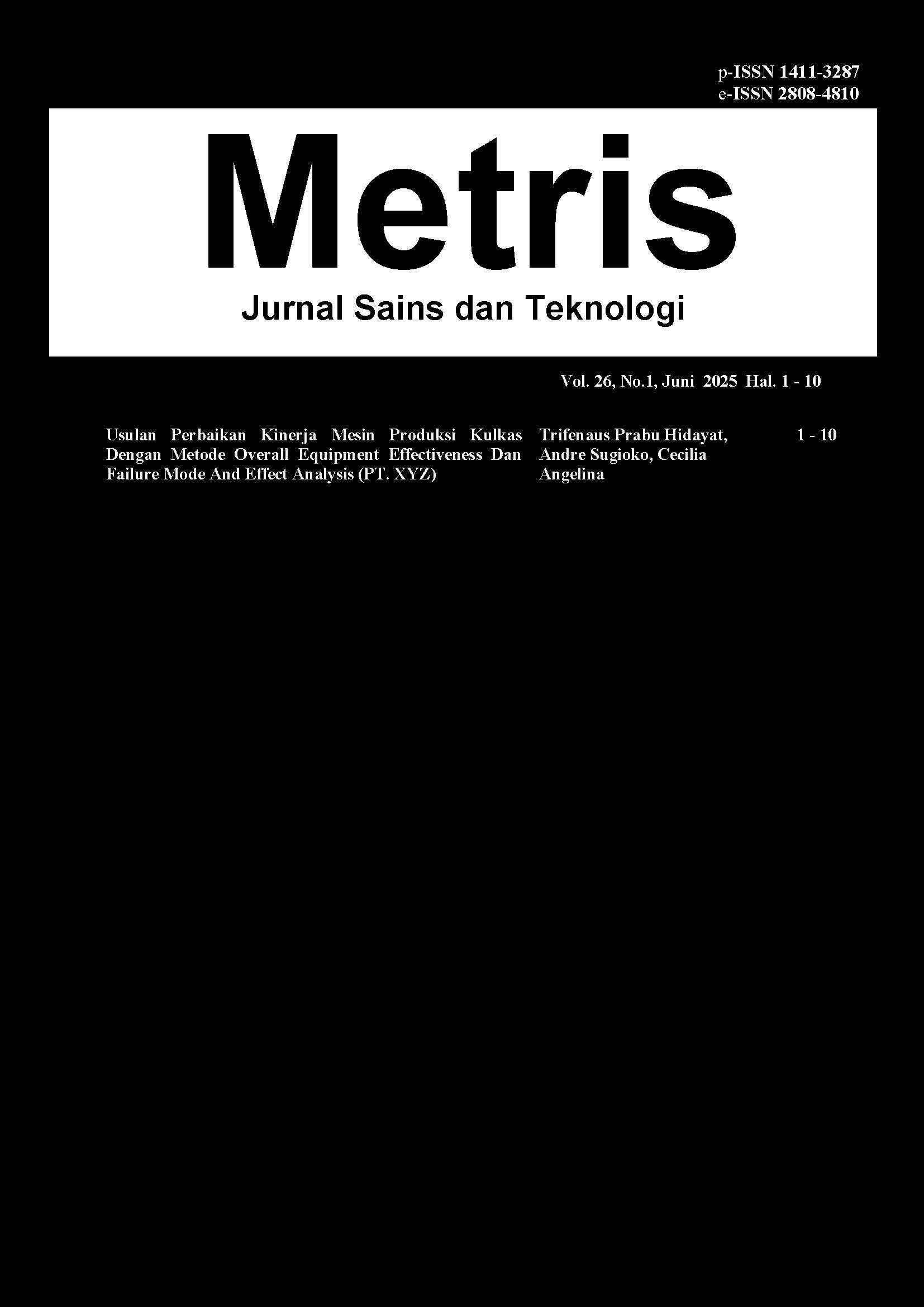Prioritas Perbaikan Aplikasi M-commerce dengan Importance Performance Matrix Analysis (IPMA)
DOI:
https://doi.org/10.25170/metris.v26i01.6782Keywords:
importance-performance matrix analysis (IPMA);, m-commerce, usability, loyaltyAbstract
The utilization of mobile commerce (m-commerce) applications is closely linked to the examination of consumer loyalty. A substantial body of research underscores the significance of m-commerce services and user acceptance in enhancing customer retention. This study aims to investigate the correlation between usability and user loyalty within m-commerce platforms by applying Importance-Performance Matrix Analysis (IPMA) to identify critical areas for improvement. The research sample comprised 149 users of m-commerce applications. Findings from the IPMA indicate that the key areas for enhancement in terms of (1) loyalty include users’ ability to exercise control, the simplicity of control mechanisms, and overall ease of use; while for (2) usability, the priority aspects for improvement are error notification features, accuracy, and completeness of the application’s functionalities
References
Abushark, Y. B., Khan, A. I., Alsolami, F. J., Almalawi, A., Alam, M. M., Agrawal, A., Kumar, R., & Khan, R. A. 2021. Usability Evaluation through Fuzzy AHP-TOPSIS Approach: Security Requirement Perspective. Computers, Materials and Continua, 68(1): 1203–1218.
Bowen, J. T., & Chen, S. 2001. The relationship between customer loyalty and customer satisfaction. International Journal of Contemporary Hospitality Management, 13(5): 213–217.
Casaló, L., Flavián, C., & Guinalíu, M. 2008. The role of perceived usability, reputation, satisfaction and consumer familiarity on the website loyalty formation process. Computers in Human Behavior, 24(2): 325–345.
Chin, W.W. 1998. The Partial Least Squares approach to Structural Equation Modeling. Modern Methods in Business Research. 1998: 295–336.
Coursair, C. K. & Kim, D. J. 2006. A qualitative review of empirical mobile usability studies. Paper presented at the 2006 Americas Conference on Information Systems (AMCIS), 2885-2897.
Coursair, C. K. & Kim, D. J., 2011. A Meta-Analytical Review of Empirical Mobile Usability Studies, Journal of Usability Studies, 6(3): 117-171.
Dawood, K. A., Sharif, K. Y., Ghani, A. A., Zulzalil, H., Zaidan, A. A. & Zaidan, B. B. 2020. Towards a unified criteria model for usability evaluation in the context of open source software based on a fuzzy Delphi method, Information and Software Technology, 130: 106453.
Gupta, D.; Ahlawat, A., Sagar, K. A. 2014. A critical analysis of a hierarchy-based usability model. 2014 International Conference on Contemporary Computing and Informatics (IC3I): 255-260.
Gupta, D., Ahlawat, A. & Sagar, K. 2017. Usability prediction and ranking of SDLC models using fuzzy hierarchical usability model. Open Engineering, 7(1): 161-168.
Hair, J. F., C. Black, W., J. Babin, B. & E. Anderson, R. 2010. Multivariate Data Analysis (7th Edition).
Hair, J.F., Hollingsworth, C.L.H., Randolph, A.B. & Chong, A.Y.L. 2017. An updated and expanded assessment of PLS-SEM in information systems research, Industrial Management & Data Systems, 117(3): 442-458.
Hair, J.F.; Sarstedt, M.; Hopkins, L.; Kuppelwieser, V.G. 2014. Partial least squares structural equation modelling (PLS-SEM): An emerging tool in business research. European Business Review, 2014: 26, 106.
Henseler, J., Ringle, C. M., & Sarstedt, M. 2014. A New Criterion for Assessing Discriminant Validity in Variance-Based Structural Equation Modeling. Journal of the Academy of Marketing Science, 43: 115-135.
Hutahaean, H.A., Silalahi, A., Hidayat, T. P., Sukwadi, R., Kartawidjaja, M.A. 2024 Persepsi Pengguna Sebagai Dasar Pengembangan Model Usability Aplikasi Mobile Commerce, Metris Jurnal Sains dan Teknologi, 25: 21-32
Jeng, J. 2004. What Is Usability in the Context of the Digital Library. Information Technology and Libraries, 24(2): 47–57. Ji, Y. G., Park, J. H., Lee, C., & Yun, M. H. 2006. A usability checklist for the usability evaluation of mobile phone user interface. International Journal of Human-Computer Interaction, 20(3): 207–231.
Lee, Y., & Kozar, K. A. 2012. Understanding of website usability: Specifying and measuring constructs and their relationships. Decision Support Systems, 52(2): 450–463.
Martilla, J.A. & James, J.C. 1977. Importance-Performance Analysis. Journal of Marketing, 41: 77–79.
Martínez-García, J.A. 2018. The consideration of the propagation of errors for the importance-performance analysis in sports management. Cuadernos de Psicologia del Deporte, 18(3): 141–149.
Muqtadiroh, F. A., Astuti, H. M., Darmaningrat, E. W. T., & Aprilian, F. R. 2017. Usability Evaluation to Enhance Software Quality of Cultural Conservation System Based on Nielsen Model (WikiBudaya). Procedia Computer Science, 124: 513–521.
Nelson, R., & Staggers, N. (2016). Health Informatics - E-Book: An Interprofessional Approach. In Health Informatics - E-Book.
Nielsen, C.M., Overgaard, M., Pedersen, M.B., Stage J. & Stenild, S. 2006. It’s worth the Hassle!: the added value of evaluating the usability of mobile systems in the field. In: NordiCHI ’06: Proceedings of the 4th Nordic Conference on Human-Computer Interaction.
Ramanayaka, K. H. 2018. Identifying Dimensions and Their Measuring Items for Library Website Usability Acceptance Model: Instrument Development and Validation. Journal of Computers, 13(7): 750–760.
Ringle, C.M. & Sarstedt, M. 2016. Gain more insight from your PLS-SEM results the importance-performance map analysis. Industrial Management & Data Systems, 116: 865–1886.
Singh, T., Malik, S. & Sarkar, D. 2016. E-commerce website quality assessment based on usability, 2016 International Conference on Computing, Communication and Automation (ICCCA): 101–105.
Sudjana, A. R. L., & Sfenrianto. 2020. A Model of Factors Influencing E-learning Usability in Toastmasters International. International Journal of Recent Technology and Engineering (IJRTE), 8(6): 327–332.
Tullis, T. & Albert, A. 2013. Measuring the user experience collecting, analyzing, and presenting usability metrics, 2nd Edition. Morgan Kaufmann, Waltham
Tenenhaus, M., Vinzi, V. E., Chatelin, Y. M., & Lauro, C. 2005. PLS path modeling. Computational Statistics and Data Analysis, 48(1): 159-205
Wolf, E. J., Harrington, K. M., Clark, S. L., & Miller, M. W. 2013. Sample Size Requirements for Structural Equation Models: An Evaluation of Power, Bias, and Solution Propriety. Educational and Psychological Measurement, 73(6): 913–934.
Wyród-Wróbel, J. & Biesok, G. 2017. Decision making on various approaches to Importance-Performance Analysis (IPA). European Journal of Business Science Technology, 3: 123–131.












